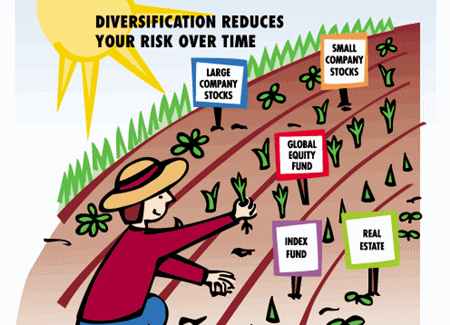How Portfolio Diversification Helps Your Investments
Post on: 3 Май, 2015 No Comment

Discussion of investing usually centers on growth type assets, like stocks, commodities or real estate. Not only are those investment generally the best performers over the long run, but they also tend to be more complex than stable, interest bearing securities. The mix of the two broad asset classes is the basis of portfolio diversification.
Why You Need Portfolio Diversification
Portfolio diversification is best described by the saying, “don’t keep all of your eggs in one basket”. To put that into investment terms, it means don’t bet all of your money on a single security or even on a single asset class.
The main purpose for portfolio diversification is minimizing risk. Though risk can never be completely eliminated, it can be reduced through a proper mix of investments. You can do this by spreading your investment capital over several assets classes, and over several individual positions within each asset class. More on this point in a bit.
Most asset classes tend to rise and fall, some more than others. While the ride up with a single asset class can be spectacular, a steep drop can wipe out all of your previous gains and then some. A well diversified portfolio can prevent you from losing all or even most of your investment capital should this happen.
3 Things to Know about Diversification
Blending Mutually Exclusive Investment Holdings
One of the key aspects of portfolio diversification is that you invest your money in various unrelated investments. Such investments are said to be mutually exclusive because the performance of one won’t affect the direction of the other. Under optimal circumstances, at least one asset class is rising at all times.
This could mean that a portfolio that’s primarily invested in stocks should also have a healthy allocation in fixed income asisets, such as Treasury Bonds or Certificates of Deposit (CD’s). The stock portion of the portfolio will fall in a declining market, but the fixed income position will remain intact and even earn interest.
It might also include having positions in real estate or natural resources such as energy and precious metals that often run counter to prevailing stock market trends. For example, during bear markets in stocks money often flows into real estate. And the spike in energy prices that often sinks the general stock markets can cause energy related investments (and even precious metals) to rise spectacularly.
Still another form of portfolio diversification is geographic. Rather than having all of your stock investments in one country, you spread your money into various foreign markets. In this way, you can have money in growing (or emerging) economies while the domestic economy is in a recession.
Diversifying Within Each Asset Class
Just as you need to diversify between asset classes, you should also diversify within each asset class. If your stock positions are held in mutual funds or exchange traded funds (ETF’s), this job is done for you. Funds typically invest in many securities within a single asset class.
If you hold individual stocks, you’ll need to invest in anywhere from ten to 20 different stocks within each market or sector. This will avoid taking huge losses from a large position in a single stock.
Fixed income assets also require diversification. Even though you have no risk of loss in Treasury securities or CD’s, you’ll still be exposed to interest rate risk. If you hold a five year CD paying 2% and rates rise to 5% six months later, you will lose 3% in interest each year going forward. To diversify against this, you can ladder the maturities in your CD portfolio such that purchases and redemptions are staggered. This doesn’t completely eliminate interest rate risk, but it does reduce it considerably.
What a Diversified Investment Portfolio Might Look Like
Portfolio diversification needs to incorporate several variables, including age, risk tolerance, future plans and your overall financial condition (job security, non-investment assets, and debt). For that reason, a portfolio will look different for every individual.

For a securely employed 35 year old, a portfolio may be split between stocks and fixed income assets in a 70/30 split 70% in stocks, 30% in fixed income. The stock position would include a mix of domestic blue chips, growth stocks, natural resources stocks, and foreign emerging stocks. Fixed income can be invested entirely in CD’s or Treasuries.
Portfolio Diversification DOES Cut Your Returns…
One aspect of portfolio diversification that bothers many investors is that diversification can reduce investment returns, at least in the short run. This happens because not all of your money will be allocated toward your highest returning investments.
As an example, let’s say that the stock market is currently returning 15% on an annual basis; if your entire portfolio is in stocks you’d earn 15% across the board. But if 50% of your money is in fixed income assets earning 2%, your total return will be just 8.5% (half of the 15% return on stock, and half of the 2% return on fixed income assets).
By diversifying your returns are reduced because you don’t participate in a rising stock market with all of your funds.
…But it also cuts your losses in a falling market
The flip side of this occurs in a falling stock market. Let’s say that stocks lose 15% for the year; if only half your portfolio is in stocks, your overall loss from stocks will be cut to 7.5%. And since your fixed income position is earning 2% on half your money (1%), your net portfolio loss for the year will be reduced from -15% to -6.5%.
There’s something more significant about the reduced loss too. If your losses were just 6.5% overall, you’d be more likely to hold your stock position in a down market because your losses would be reduced. That will put you in a better position when stocks begin to rise again.
What portfolio diversification does more than anything is to make your returns more consistent over the long run. Wild swings in either direction are reduced improving your long term investment success. If youre a long term investor, this is a big advantage.














